Overview
I’m a mathematician with a strong interest in applied data science and its interdisciplinary impact. My background enables me to approach complex data-driven problems in a diverse array of fields like computational imaging/signal processing (PhD focus), customer behavior modeling, machine learning, DevOps, and financial risk analysis. I am very passionate about developing data-centric solutions that advance both technology and sustainability. I have outlined my relevant data scientific skills, background and project experiences below.
Skills
Machine Learning and AI: Supervised/Unsupervised learning, Forests, (Deep, Conv) Neural networks, XGBoost, etc.
Data Science: Regressions, Predictive modelling, Topological Data Analysis, Statistical/Stochastic Learning, etc.
Programming Languages: Python, R, SQL, Julia, C++.
Tools: PyTorch, Tensorflow, Scikit-learn, Numpy, Langchain, BI/Tableau.
Certificates: Data Analytics, Adv. Data Analytics (Google), Adv. Learning Algorithms (DeepLearning.ai), AWS.
Data Projects Summary
Predicting spatiotemporal dynamics of Chronic Wasting Disease (CWD) in KS
- Link: Manuscript in preparation.
- Goal: Develop a dynamic model to predict presence and spread of CWD in KS from highly unbalanced data.
- Context: Project done as an inter-disciplinary collab. with the dept. of Veterinary Pathobiology and MUIDSI.
- Deliverables:
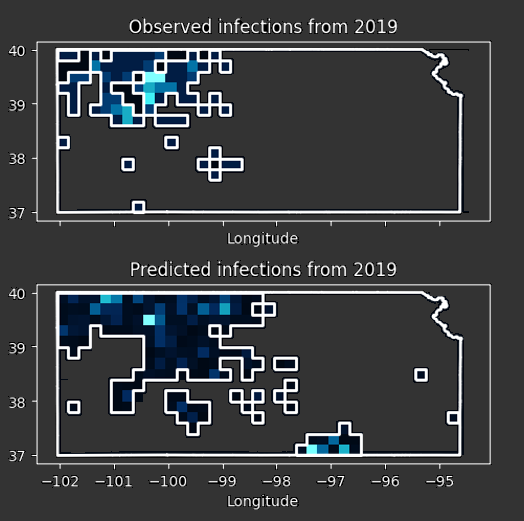
- Developed a (dynamic) spatiotemporal model capturing CWD movement in KS
- Performed parameter-fine tuning through cross-validation with sampling data
- Performance:
- Max accuracy (fixed time, over space): 90.16%
- Min accuracy (fixed time, over space): 85.11%
- Overall accuracy (across space and time): 88.13%
- Confirmed established trends, identified new migration pathways and suggested intervention measures.
- Derived novel means to quantify the rate and direction of spread of disease
- Developed ways to estimate rates and direction at different scales
- Future work:
- Aggregated KS soil covariate and land cover data and performed PCA to improve model performance
- Esimated improved accuracy after covariate integration $\sim$ 93% [analysis underway]
Predicting passenger survival aboard Titanic - Kaggle competition

- Link: Kaggle notebook
- Goal: Predict passenger survival aboard the Titanic.
- Context: Project done as a part of the Kaggle machine learning competition
- Deliverables:
- Placed in the top 1.3% globally with a bagged random forest model (with conditionally imputed trees)
- Performed EDA and engineered nine new features, five of which were highly correlated with Survival
- Evaluated various models with training accuracy as high as 83.3% under a 10-fold cross validation
- Champion model: Bagged random forest
- Test accuracy: 81.334%
- CV standard deviation: 0.06%
Predicting user churn with Waze data
- Link: GitHub
- Goal: Predict user churn behavior by analyzing data collected from Waze app.
- Data Source: Waze app (via Google)
- Context: Project done as a part of an advanced data analytics certification powered by Google.
- Deliverables:
- EDA findings that indicated churn trends based on distance driven.
- Engineered features that improved predictive power of the champion model.
- Built regression and machine learning models that predicted user churn behavior.
- Champion model: XGB-classifier
- Accuracy: 81%
- Recall: 16.5%
- Champion model: XGB-classifier
Harvest the sun! - Optimizing solar practicality across mainland US
- Link: Blog post
- Goal: Rank states/zip based on the socio-economic feasibility of installing solar panels to the median house.
- Data source: Project sunroof, Google.
- Context: Project done as a part of a data analytics certification powered by Google.
- Deliverables:
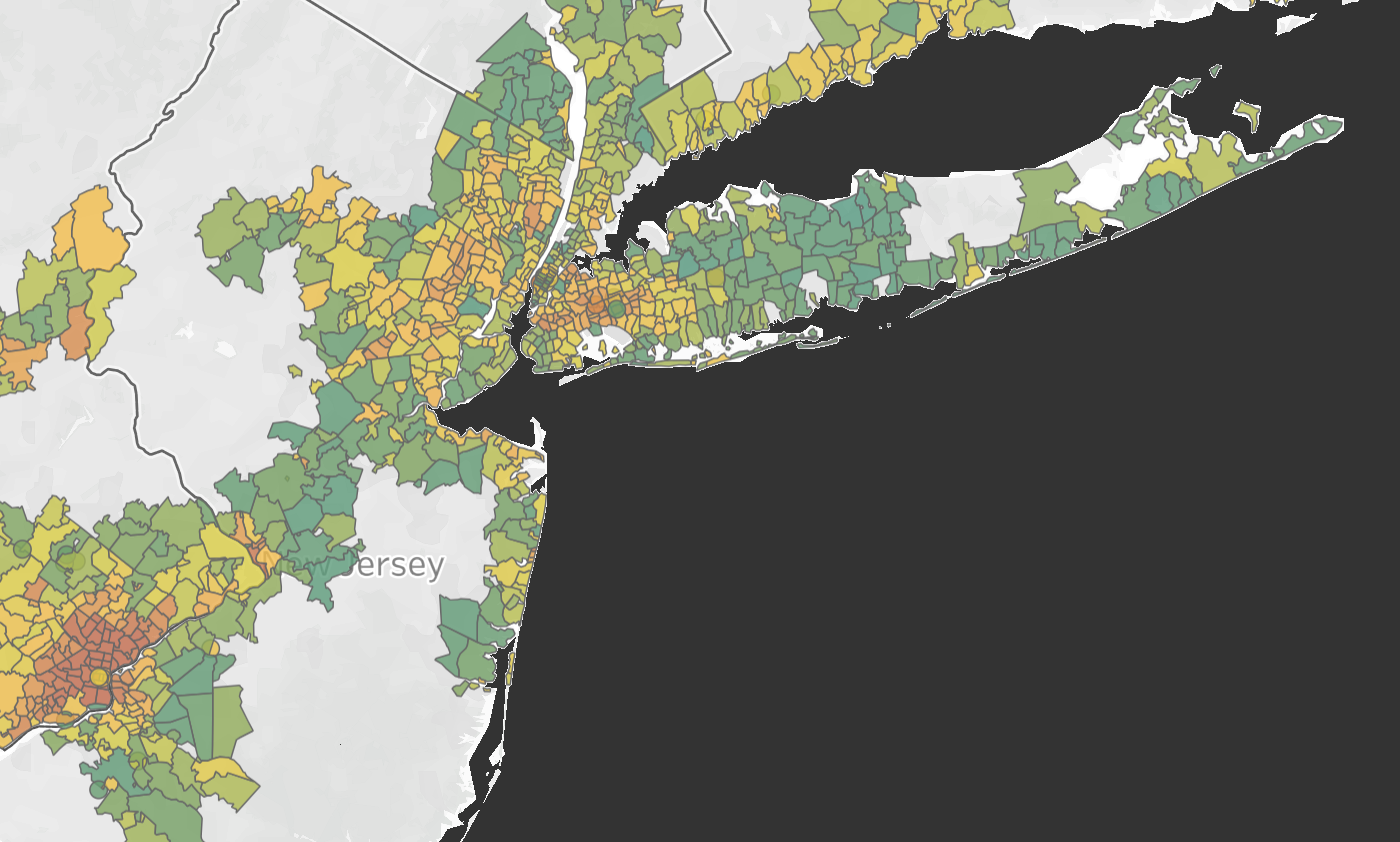
- Engineered three indices that captured unique aspects of solar feasibility.
- Impact index: Amount of CO2 offset per installation.
- Economical index: Short term costs and govt. subsidies for installation.
- Savings index: Long term savings, EB offset from installation.
- Designed a Tableau dashboard to communicate findings.
- Engineered three indices that captured unique aspects of solar feasibility.
Nucleation of market bubbles
- Link: GitHub
- Goal: Adapt physical nucleation theory (JMAK) to the financial sector to predict market bubbles
- Data source: FRED economic data
- Context: Project done as a part of undergraduate senior capstone project
- Deliverables:
- Recontextualized the Avrami-JMAK equations, from physical nucleation theory, to the financial setting.
- Fitted model to 2007 housing data to identify scale-invariant indicators of formation/collapse of bubbles.
- Model RMS error: 12% over prior bubble phases of stocks from selected sectors.
Topological Data Analysis
- Link: Blog posts - Part 1, Part 2, Part 3
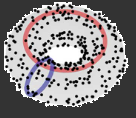
- Goal: Build a topological machine learning pipeline that classifies shapes based on topological features.
- Context: Project done as a part of doctoral comprehensive exams on topological data analysis.
- Deliverables:
- Implemented a topological ML pipeline that
- Extracted underlying topological information from point clouds (persistence barcodes).
- Trained a random forest classifier on the topological features.
- Achieved considerable dimension reduction by reducing number of training features from $O(3N)$ to $O(1)$, while retaining competitive performance.
- Out-of-bag accuracy scores:
- Synthetic data: 100%
- Real life data: 82.5% (Source: Princeton computer vision course)
- Implemented a topological ML pipeline that
Robust Subspace Recovery
- Link: GitHub
- Goal: Extract a smaller dimensional subspace that contains “enough” points of a partitioned point cloud $\mathcal{X}$
- Context: Project done as a part of doctoral comprehensive exams on quiver representation theory
- Deliverables:
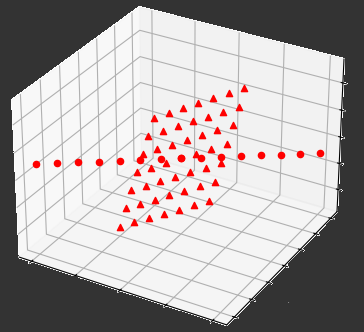
- Implemented an algorithm that extracted a smaller linear subspace that contains enough points of $\mathcal{X}$
- Furthermore, the extraction was simultaneous in the following sense:
- $\mathcal{X}$ is formed by concatenating various point clouds into a single matrix
- The extracted subspace contains enough points of this concatenation
- Helps mitigate cases where such a recovery is not possible given only a single factor of the concatenation.
ML and programming
Solving mazes and simulating cycles - a saga of genetic algorithm
Link: GitHub - Maze Solver, ODE Parameter Estimator. Blog post - coming soon
Goal: Implement agents guided by the genetic algorithm to
- Solve a randomly generated maze
- Estimate the parameters of a coupled system of Ordinary Differential Equations
Deliverables: Developed agents (with hereditary genes) that
- Solved a randomly generated maze in $O(M*N^2)$ time
- Estimated parameters of the Predator-Prey system within $5$ generations of $5$ agents each.
- Here is a sample run:
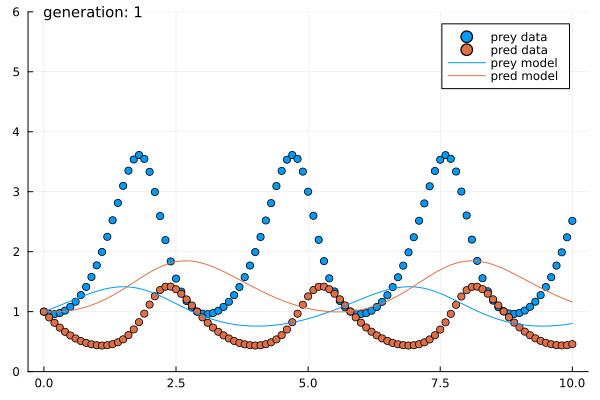
- Here is a sample run:
Numeripy - python package
Goal: Develop a python package containing numerical ODE solvers and matrix methods
Deliverables:
numeripy.ODE_solversoffers numerical ODE solvers that offer robust precision control and flexibilitynumeripy.matrix_methodsoffers matrix methods aimed for use in numerical linear algebra tools- In addition,
numeripy.latexit()generates latex formatted tables ready to be pasted into a LaTeX document